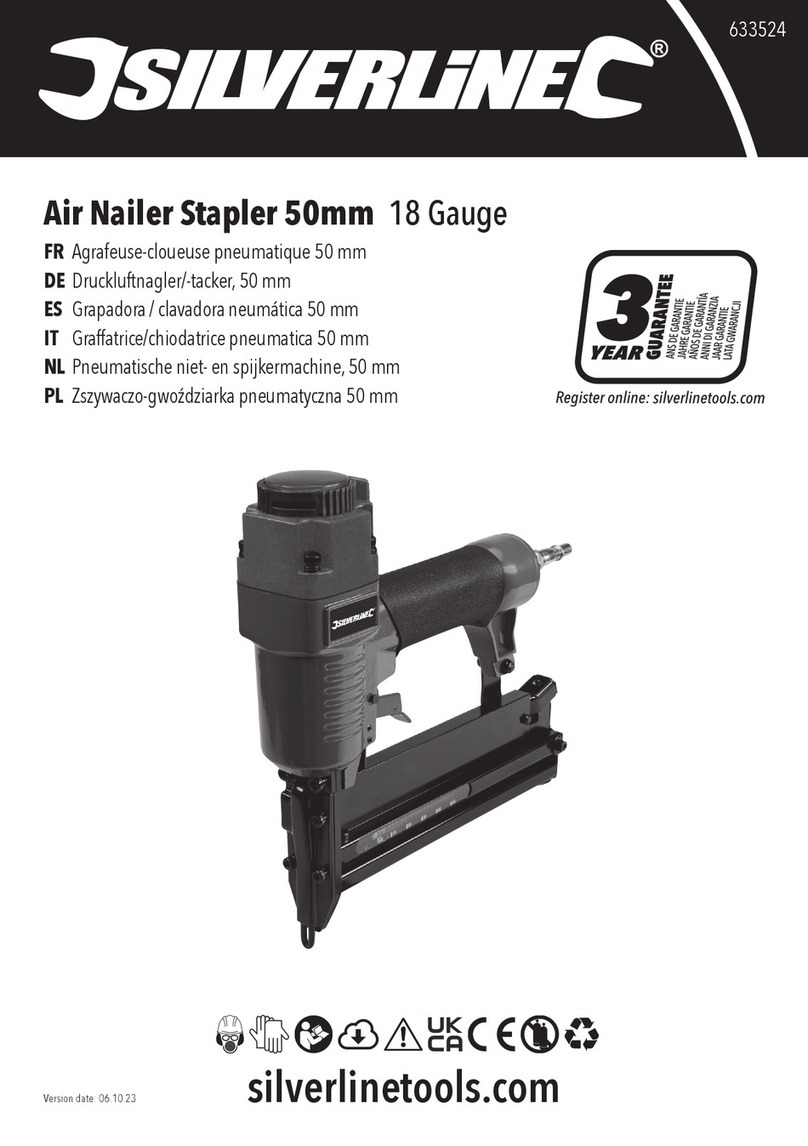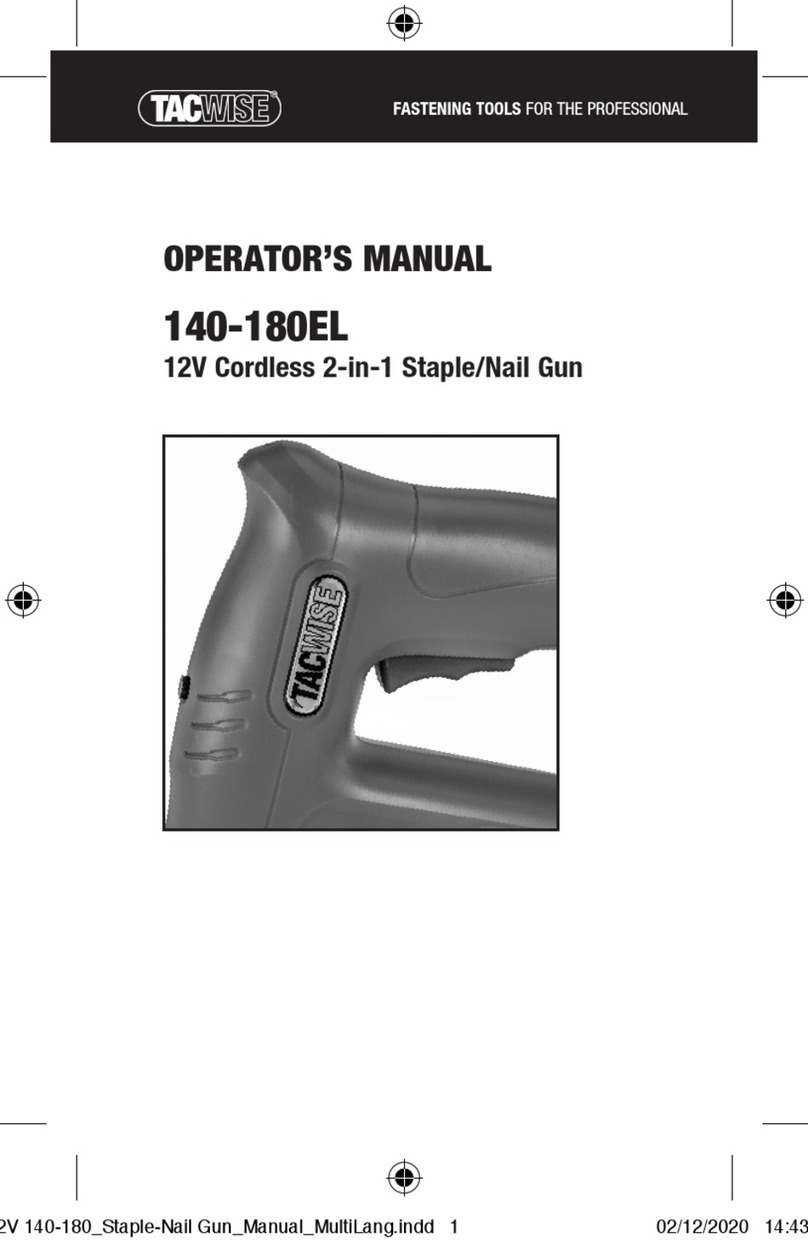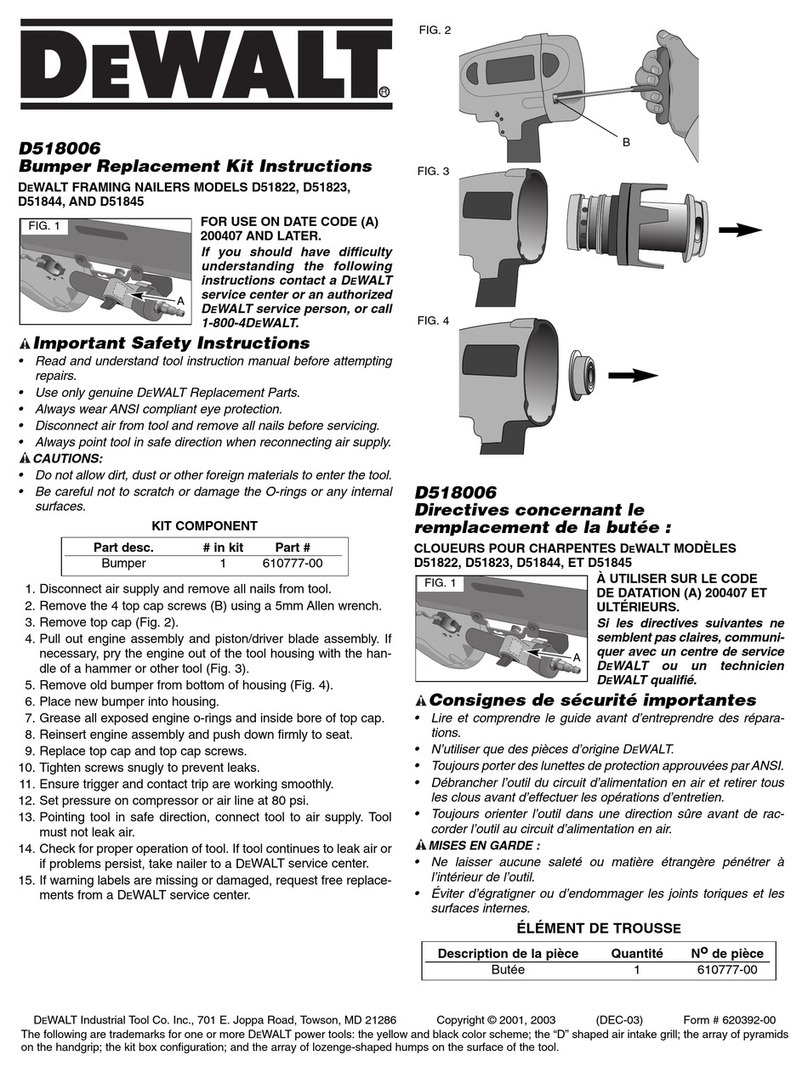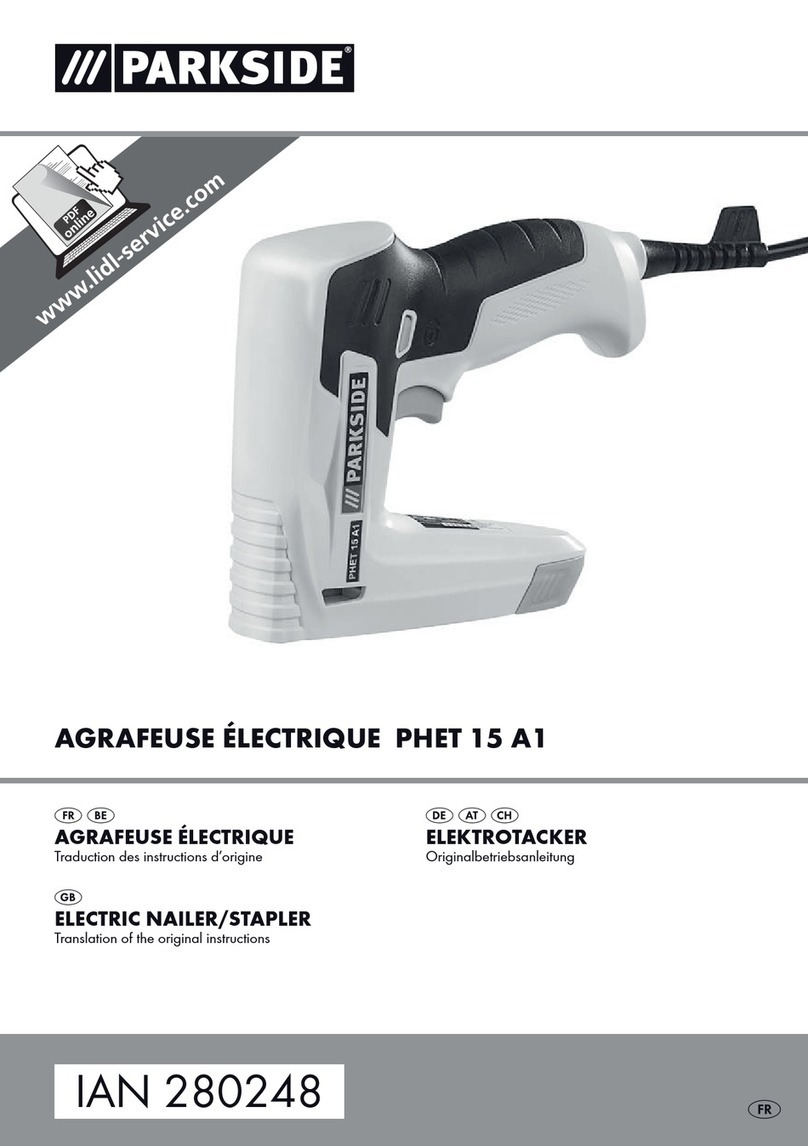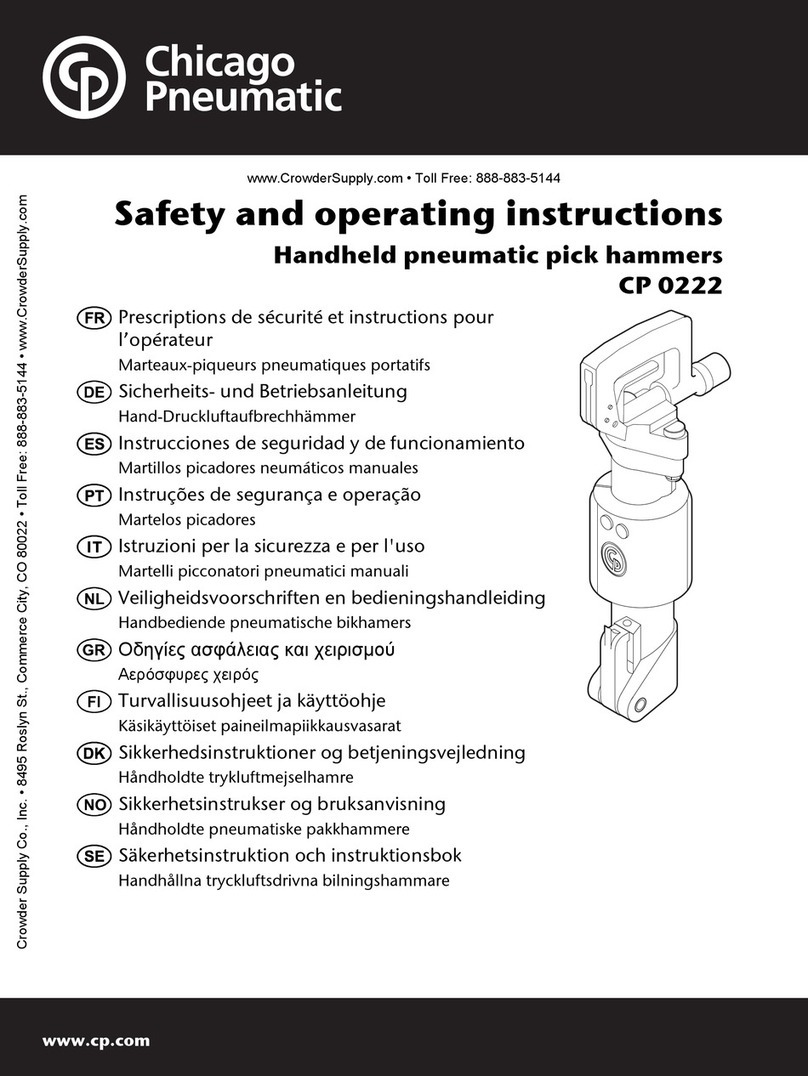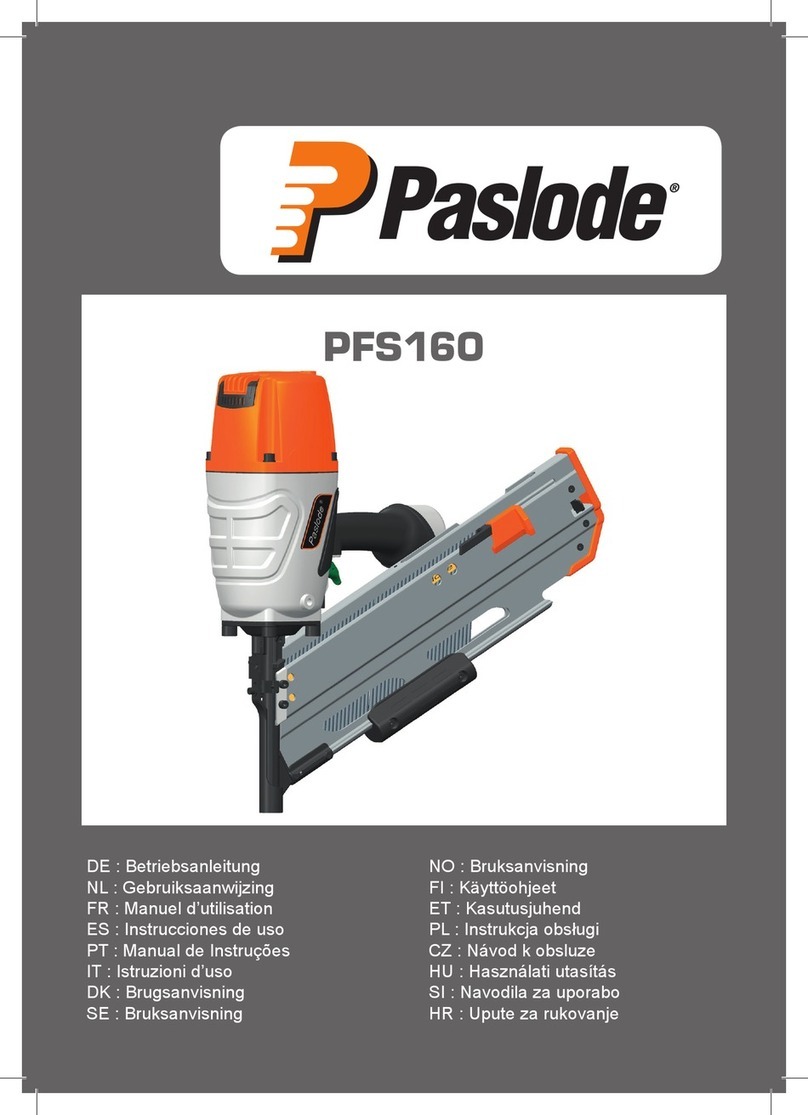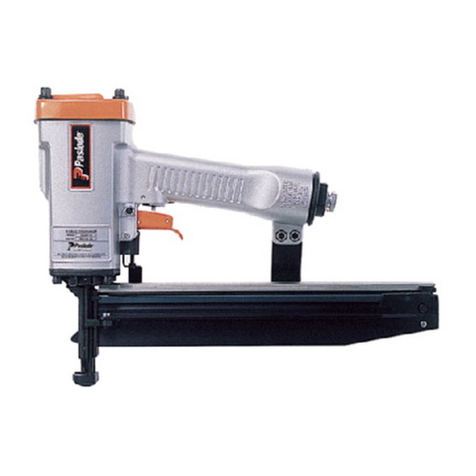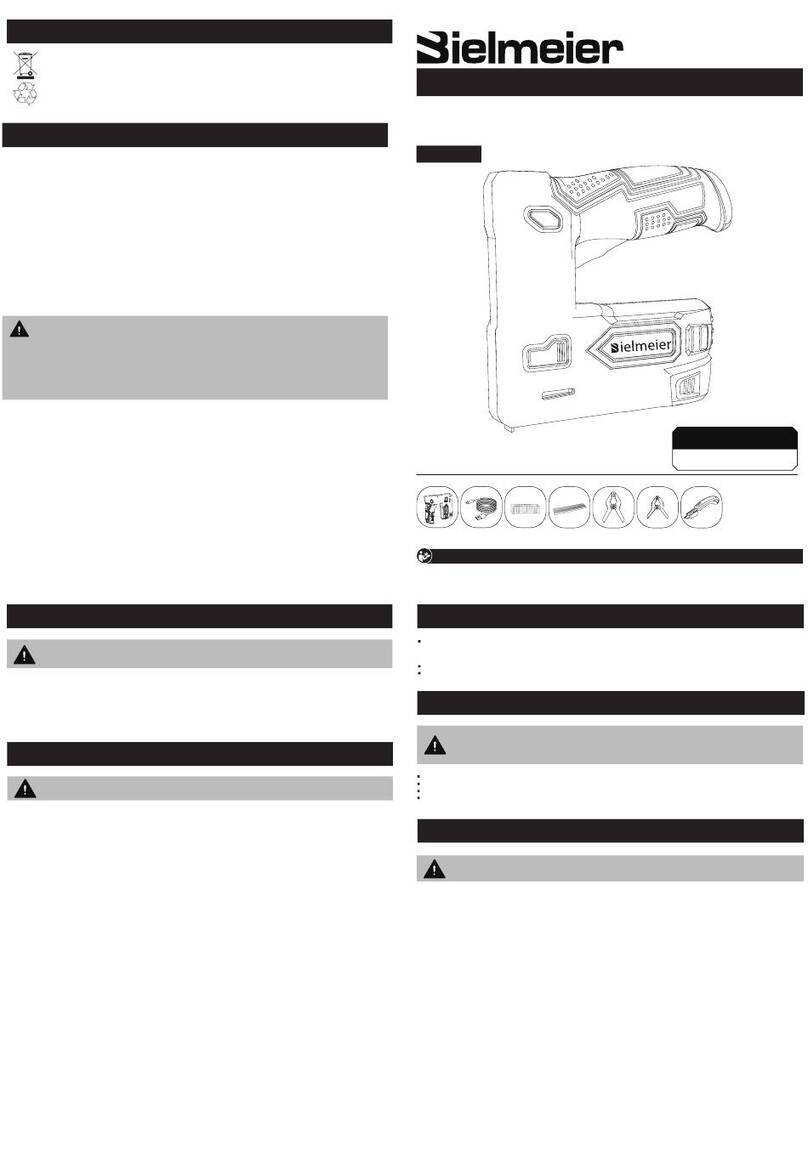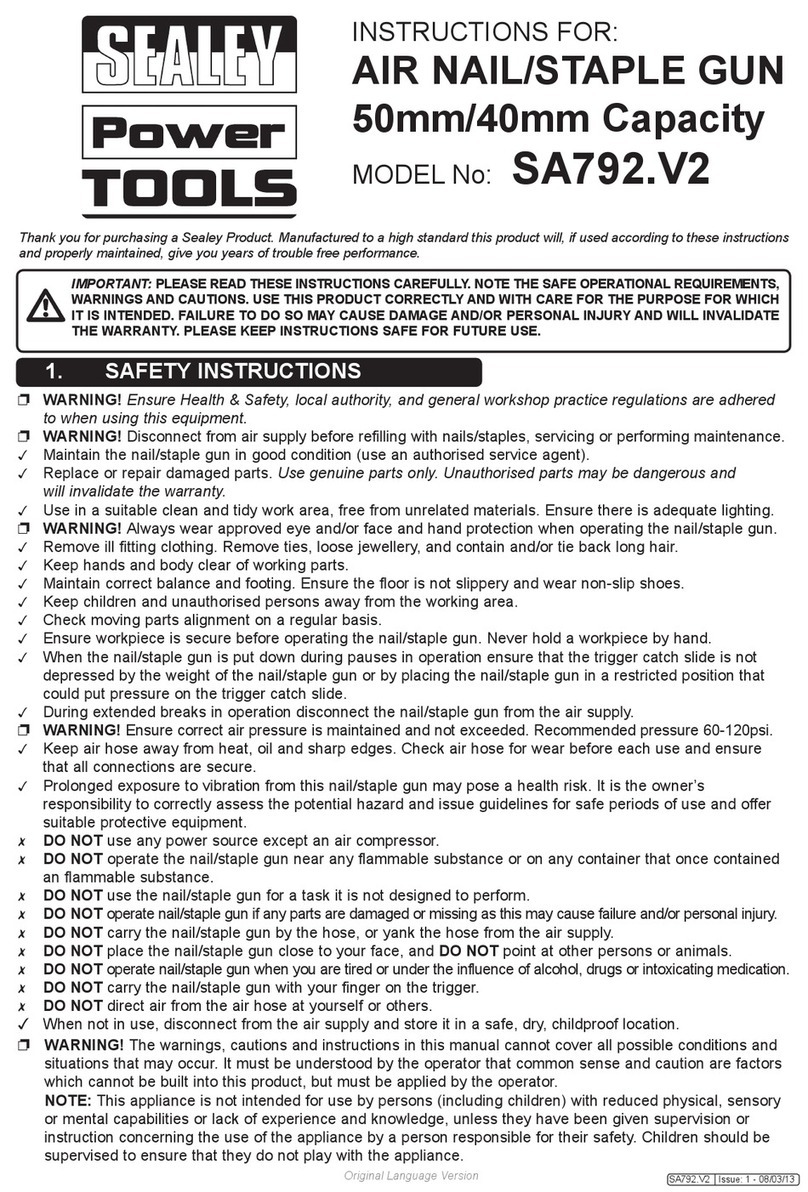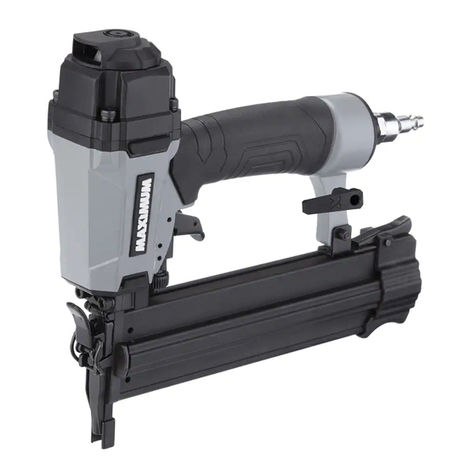Flex FX4331 User manual

OPERATOR’S MANUAL
MANUAL DEL OPERADOR
MANUEL DE L’UTILISATEUR
833-FLEX-496
(833-3539-496)
For English
Version
See page 2
◆
Version
française
Voir page 20
◆
Versión en
español
Ver la página 40
www.Registermyflex.com
Contact Us /
Nous contacter /
Contáctenos
Model:
Modelo:
Modèle:
24V 18GA BRAD NAILER
CLOUEUR POUR CLOUS DE VITRIER 18GA DE 24 V
CLAVADORA DE CLAVOS TIPO PUNTILLA DE 18 GA DE 24 V
FX4331

-2-
SAFETY SYMBOLS
The purpose of safety symbols is to attract your attention to possible dangers. The safety symbols
and the explanations with them deserve your careful attention and understanding. The symbol
warnings do not, by themselves, eliminate any danger. The instructions and warnings they give are
no substitutes for proper accident prevention measures.
WARNING Be sure to read and understand all safety instructions in this Owner's Manual,
including all safety alert symbols such as “DANGER,” “WARNING,” and
“CAUTION” before using this tool. Failure to follow all instructions listed below may result in electric
shock, re, and/or serious personal injury.
The denitions below describe the level of severity for each signal word. Please read the manual and
pay attention to these symbols.
This is the safety alert symbol. It is used to alert you to potential personal
injury hazards. Obey all safety messages that follow this symbol to avoid
possible injury or death.
DANGER DANGER indicates a hazardous situation which, if not avoided, will result in
death or serious injury.
WARNING WARNING indicates a hazardous situation which, if not avoided, could result
in death or serious injury.
CAUTION CAUTION, used with the safety alert symbol, indicates a hazardous situation
which, if not avoided, will result in minor or moderate injury.
Damage Prevention and Information Messages
These inform the user of important information and/or instructions that could lead to equipment or
other property damage if they are not followed. Each message is preceded by the word “NOTICE”,
as in the example below:
NOTICE: Equipment and/or property damage may result if these instructions are not followed.
WARNING The operation of any power tools can result in foreign
objects being thrown into your eyes, which can result in
severe eye damage. Before beginning power tool operation, always wear
safety goggles or safety glasses with side shields and a full face shield when
needed. We recommend a Wide Vision Safety Mask for use over eyeglasses
or standard safety glasses with side shields. Always use eye protection which
is marked to comply with ANSI Z87.1.

-3-
IMPORTANT SAFETY WARNINGS
WARNING Read all safety warnings, instructions, illustrations and specications
provided with this power tool. Failure to follow all instructions listed below may
result in electric shock, re and/or serious injury.
SAVE ALL WARNINGS AND INSTRUCTIONS FOR FUTURE REFERENCE.
The term “power tool” in the warnings refers to your mains-operated (corded) power tool or battery-
operated (cordless) power tool.
Work area safety
Keep work area clean and well lit. Cluttered
or dark areas invite accidents.
Do not operate power tools in explosive
atmospheres, such as in the presence of
ammable liquids, gases or dust. Power
tools create sparks which may ignite the dust or
fumes.
Keep children and bystanders away while
operating a power tool. Distractions can cause
you to lose control.
Electrical safety
Power tool plugs must match the outlet.
Never modify the plug in any way. Do
not use any adapter plugs with earthed
(grounded) power tools. Unmodied plugs
and matching outlets will reduce risk of electric
shock.
Avoid body contact with earthed or
grounded surfaces, such as pipes, radiators,
ranges and refrigerators. There is an
increased risk of electric shock if your body is
earthed or grounded.
Do not expose power tools to rain or wet
conditions. Water entering a power tool will
increase the risk of electric shock.
Do not abuse the cord. Never use the cord
for carrying, pulling or unplugging the
power tool. Keep cord away from heat, oil,
sharp edges or moving parts. Damaged or
entangled cords increase the risk of electric
shock.
When operating a power tool outdoors, use
an extension cord suitable for outdoor use.
Use of a cord suitable for outdoor use reduces
the risk of electric shock.
If operating a power tool in a damp location
is unavoidable, use a ground fault circuit
interrupter (GFCI) protected supply. Use of a
GFCI reduces the risk of electric shock.
Personal safety
Stay alert, watch what you are doing and
use common sense when operating a power
tool. Do not use a power tool while you are
tired or under the inuence of drugs, alcohol
or medication. A moment of inattention while
operating power tools may result in serious
personal injury.
Use personal protective equipment. Always
wear eye protection. Protective equipment
such as a dust mask, non-skid safety shoes,
hard hat or hearing protection used for
appropriate conditions will reduce personal
injuries.
Prevent unintentional starting. Ensure
the switch is in the off-position before
connecting to power source and/or battery
pack, picking up or carrying the tool.
Carrying power tools with your nger on the
switch or energizing power tools that have the
switch on invites accidents.
Do not overreach. Keep proper footing
and balance at all times. This enables
better control of the power tool in unexpected
situations.
Dress properly. Do not wear loose clothing
or jewelry. Keep your hair, and clothing away
from moving parts. Loose clothes, jewelry or
long hair can be caught in moving parts.
If devices are provided for the connection
of dust extraction and collection facilities,
ensure these are connected and properly
used. Use of dust collection can reduce dust-
related hazards.
Do not let familiarity gained from frequent
use of tools allow you to become
complacent and ignore tool safety
principles. A careless action can cause severe
injury within a fraction of a second.

-4-
Power tool use and care
Do not force the power tool. Use the correct
power tool for your application. The correct
power tool will do the job better and safer at the
rate for which it was designed.
Do not use the power tool if the switch
does not turn it on and off. Any power tool
that cannot be controlled with the switch is
dangerous and must be repaired.
Disconnect the plug from the power
source and/or remove the battery pack,
if detachable, from the power tool before
making any adjustments, changing
accessories, or storing power tools. Such
preventive safety measures reduce the risk of
starting the power tool accidentally.
Store idle power tools out of the reach of
children and do not allow persons unfamiliar
with the power tool or these instructions
to operate the power tool. Power tools are
dangerous in the hands of untrained users.
Maintain power tools and accessories.
Check for misalignment or binding of
moving parts, breakage of parts and any
other condition that may affect the power
tool’s operation. If damaged, have the power
tool repaired before use. Many accidents are
caused by poorly maintained power tools.
Keep cutting tools sharp and clean. Properly
maintained cutting tools with sharp cutting
edges are less likely to bind and are easier to
control.
Use the power tool, accessories and
tool bits etc. in accordance with these
instructions, taking into account the working
conditions and the work to be performed.
Use of the power tool for operations different
from those intended could result in a hazardous
situation.
Keep handles and grasping surfaces dry,
clean and free from oil and grease. Slippery
handles and grasping surfaces do not allow
for safe handling and control of the tool in
unexpected situations.
Battery tool use and care
Recharge only with the charger specied by
the manufacturer. A charger that is suitable for
one type of battery pack may create a risk of re
when used with another battery pack.
Use power tools only with specically
designated battery packs. Use of any other
battery packs may create a risk of injury and
re.
When battery pack is not in use, keep it
away from other metal objects, like paper
clips, coins, keys, nails, screws or other
small metal objects, that can make a
connection from one terminal to another.
Shorting the battery terminals together may
cause burns or a re.
Under abusive conditions, liquid may be
ejected from the battery; avoid contact.
If contact accidentally occurs, ush with
water. If liquid contacts eyes, additionally
seek medical help. Liquid ejected from the
battery may cause irritation or burns.
Do not use a battery pack or tool that is
damaged or modied. Damaged or modied
batteries may exhibit unpredictable behavior
resulting in re, explosion or risk of injury.
Do not expose a battery pack or tool to re
or excessive temperature. Exposure to re or
temperature above 265 °F (130 °C) may cause
explosion.
Follow all charging instructions and do
not charge the battery pack or tool outside
the temperature range specied in the
instructions. Charging improperly or at
temperatures outside the specied range may
damage the battery and increase the risk of re.
Service
Have your power tool serviced by a
qualied repair person using only identical
replacement parts. This will ensure that the
safety of the power tool is maintained.
Never service damaged battery packs.
Service of battery packs should only be
performed by the manufacturer or authorized
service providers.

-5-
NAILER SAFETY WARNINGS
• Always assume that the tool contains
fasteners. Careless handling of the nailer can
result in unexpected ring of fasteners and
personal injury.
• Do not point the tool towards yourself or
anyone nearby. Unexpected triggering will
discharge the fastener causing an injury.
• Do not actuate the tool unless the tool is
placed firmly against the workpiece. If the
tool is not in contact with the workpiece, the
fastener may be deected away from your
target.
• Disconnect the tool from the power source
when the fastener jams in the tool. While
removing a jammed fastener, the nailer may
be accidentally activated if it is plugged in.
• Use caution while removing a jammed
fastener. The mechanism may be under
compression and the fastener may be
forcefully discharged while attempting to free a
jammed condition.
• Do not use this nailer for fastening
electrical cables. It is not designed for
electric cable installation and may damage the
insulation of electric cables thereby causing
electric shock or re hazards.
• Hold power tool by insulated gripping
surfaces, when performing an operation
where the fastener may contact hidden
wiring. Fasteners contacting a “live” wire may
make exposed metal parts of the power tool
“live” and could give the operator an electric
shock.
WARNING
Drilling, sawing, sanding or machining wood
products can expose you to wood dust, a
substance known to the State of California to
cause cancer. Avoid inhaling wood dust or use
a dust mask or other safeguards for personal
protection. For more information go to
www.P65Warnings.ca.gov/wood
Some dust created by power sanding, sawing,
grinding, drilling and other construction activities
contains chemicals known to the State of
California to cause cancer, birth defects or other
reproductive harm. Some examples of these
chemicals are:
– Lead from lead-based paints.
– Crystalline silica from bricks, cement, and
other masonry products.
– Arsenic and chromium from chemically-treated
lumber.
Your risk from these exposures varies,
depending upon how often you do this type
of work. To reduce your exposure to these
chemicals:
– Work in a well-ventilated area.
– Work with approved safety equipment, such
as dust masks that are specially designed to
lter out microscopic particles.
– Avoid prolonged contact with dust from power
sanding, sawing, grinding, drilling, and other
construction activities. Wear protective clothing
and wash exposed areas with soap and water.
Allowing dust to get into your mouth or eyes or
to lie on the skin may promote absorption of
harmful chemicals.

-6-
SYMBOLS
IMPORTANT: Some of the following symbols may be used on your tool. Please study them and
learn their meaning. Proper interpretation of these symbols will allow you to operate the tool better
and safer.
Symbol Name Designation/Explanation
V Volts Voltage
A Amperes Current
Hz Hertz Frequency (cycles per second)
W Watt Power
kg Kilograms Weight
min Minutes Time
s Seconds Time
Wh Watt-hours Battery capacity
Ah Ampere-hours Battery capacity
ø Diameter Size of drill bits, grinding wheels, etc.
n0No load speed Rotational speed, at no load
n Rated speed Maximum attainable speed
…/min Revolutions or reciprocations per
minute (rpm)
Revolutions, strokes, surface speed, orbits,
etc. per minute
O Off position Zero speed, zero torque...
1,2,3,…
Ⅰ,Ⅱ,Ⅲ, Selector settings Speed, torque, or position settings. Higher
number means greater speed
Innitely variable selector with off Speed is increasing from 0 setting
Arrow Action in the direction of arrow
Alternating current (AC) Type or a characteristic of current
Direct current (DC) Type or a characteristic of current
Alternating or direct current
(AC / DC) Type or a characteristic of current
Class II tool Designates Double Insulated Construction
tools.
Protective earth Grounding terminal
Li-ion RBRC seal Designates Li-ion battery recycling
program
Read the instructions Alerts user to read manual

-7-
Symbol Name Designation/Explanation
Wear eye protection symbol Alerts user to wear eye protection
Always operate with two hands Alerts user to always operate with two
hands
Do not use the guard for cut-off
operations Do not use the guard for cut-off operations
No-Hands Zone
The area between the marked lines on the left
and right side of the base. This zone is
identied by the No-Hands Zone
symbols inside the lines marked on the base.
Warning symbol Do not stare at operating lamp
Keep Hands Away Keep hands and body away from the
discharge area of the tool.

-8-
SYMBOLS (CERTIFICATION INFORMATION)
Symbol Designation/Explanation
This symbol designates that this tool is listed by Underwriters Laboratories.
This symbol designates that this component is recognized by Underwriters
Laboratories.
This symbol designates that this tool is listed by Underwriters Laboratories,
to United States and Canadian Standards.
This symbol designates that this tool is listed by the Canadian Standards
Association.
This symbol designates that this tool is listed by the Canadian Standards
Association, to United States and Canadian Standards.
This symbol designates that this tool is listed by the Intertek Testing
Services, to United States and Canadian Standards.

-9-
FUNCTIONAL DESCRIPTION AND SPECIFICATIONS
18GA BRAD NAILER
Fig. 1
Workpiece
Contact
Magazine
Release Button
Magazine
LED Work Light
Trigger Switch
Jam Release Latch
Handle
Removable Hook
Nail
Indicator
Windows
Power Switch
Depth Selector
No-mar Pad
Mode Select
Button
Contact
Actuation Mode
Single Sequential
Actuation Mode

-10-
Model No. FX4331
Rated Voltage 24V d. c.
Magazine Capacity 110 Nails
Nail Type 18 Ga (18 Gauge)
Brad Nail Length 5/8” – 2-1/8” (16mm – 54mm)
Recommended Ambient operating temperature -4 – 104 °F (-20 – 40°C)
Recommended storage temperature < 122°F (< 50°C)

-11-
ASSEMBLY
WARNING Detach the battery pack
from the tool before
performing any assembly or adjustments, or
changing accessories. Such preventive safety
measures reduce the risk of starting the tool
accidentally.
TO ATTACH/DETACH BATTERY PACK (FIG. 2)
To attach the battery pack:
Align the raised rib on the battery pack with the
grooves in the tool, and then slide the battery
pack onto the tool.
NOTICE: When placing the battery pack
onto the tool, be sure that the raised rib
on the battery pack aligns with the groove
inside the tool and that the latches snap into
place properly. Improper attachment of the
battery pack can cause damage to internal
components.
To detach the battery pack:
Depress battery-release button located on the
front of the battery pack to release the battery
pack. Pull the battery pack out and remove it
from the tool.
WARNING Do not attempt to modify
this tool or create
accessories not recommended for use with
this tool. Any such alteration or modication is
misuse and could result in a hazardous
condition leading to possible serious injury.
REMOVABLE HOOK (FIG. 3)
Your tool is shipped with a removable hook that
can be positioned on either side of the tool. The
hook can be used to hang the tool on a belt.
Install the hook onto the tool:
a. Remove the battery pack from the tool.
b. Align the two pins of the hook with the holes
on the base of the tool.
c. Insert the screw and securely tighten the
screw with a Phillips screwdriver (not
included).
Remove the hook from the tool:
a. Remove the battery pack from the tool.
b. Use a screwdriver to loosen the screw that
attaches the hook to the tool.
c. Remove the screw and the hook.
Fig. 2
Attach
Detach
Battery-Release
Button
Fig. 3
Removable Hook
Pin

-12-
NO-MAR PAD (FIG. 4)
WARNING Remove the battery pack
from the tool before
removing or replacing the no-mar pad.
Failure to do so could result in serious personal
injury.
The no-mar pad attached to the nose of the
tool helps prevent marring and denting the work
surface when working with softer woods.
The no-mar pad can be removed by pulling it
down and away from the workpiece contact. To
replace the no-mar pad, t it into place over the
workpiece contact and push up at the back to
reseat.
On-board storage for the no-mar pad is located
on the magazine of the tool. A spare no-mar pad
is provided in the on-board storage area.
TO LOAD OR REMOVE BRAD NAILS (FIG. 5)
WARNING Remove the battery pack
from the tool before
loading or removing nails. Failure to do so
could result in serious personal injury.
WARNING Keep the tool pointed
away from yourself and
others when loading nails. Failure to do so
could result in possible serious personal injury.
WARNING Use only the nails
recommended for use with
this tool. The use of any other nails can result
in tool malfunction, leading to serious injuries.
WARNING Never load nails with the
workpiece contact or trigger
activated. Doing so could result in possible
serious personal injury.
To Load Brad Nails:
a. Remove the battery pack from the tool.
b. With the nose of the tool pointed away from
you, squeeze the magazine release button
located at the rear of the magazine and slide
the magazine open.
c. Place the brad nails in the channel with the
nail tips pointing down and resting on the
bottom of the channel.
d. Push the magazine and squeeze the
magazine release button to close it until it
securely snaps into place.
e. Make sure that the magazine is securely
locked in place.
f. Reattach the battery pack, and reactivate the
nailer by pressing the power switch.
You can observe the number of remaining nails
through the nail indicator windows, and load
more nails as needed.
To Remove Brad Nails:
a. Remove the battery pack from the tool.
b. Squeeze the magazine release button located
at the rear of the magazine and slide the
magazine open.
c. Remove the nails.
d. Close the magazine and make sure that it is
securely locked in place.
Fig. 4
No-mar Pad
On-board Storage
Fig. 5
Top
Nail Tips
Magazine
Magazine
Release
Button
Nail
Indicator
Windows

-13-
OPERATING INSTRUCTIONS
WARNING To reduce the risk of re,
personal injury, and
product damage due to a short circuit, never
immerse your charger or battery pack in
uid or allow a uid to ow inside them.
Corrosive or conductive uids, such as
seawater, certain industrial chemicals, and
bleach or bleach-containing products, etc. can
cause a short circuit.
WARNING If any parts are damaged
or missing, do not operate
this product until the parts are replaced. Use
of this product with damaged or missing parts
could result in serious personal injury.
WARNING To prevent accidental
starting that could cause
serious personal injury, always remove the
battery pack from the tool when assembling
or adjusting parts.
WARNING Always wear eye
protection. Eye protection
does not t all operators in the same way. Make
sure the eye protection chosen has side shields
or provides protection from ying debris both
from the front and sides.
WARNING Do not use this nailer for
fastening electrical cables.
It is not designed for electric cable installation
and may damage the insulation of electric
cables thereby causing electric shock or re
hazards.
This brad nailer must be used only with the battery packs and chargers listed below:
Battery Pack
Charger
2.5Ah 3.5Ah 5.0Ah 6Ah 8.0Ah 10Ah 12Ah
FX0111 FX0321 FX0121 FX0331 FX0221 FX0341 FX0231 FLEX
FX0411
FLEX
FX0421
FLEX
FX0431
FLEX
FX0451
NOTE: Please refer to the battery pack and charger manuals for detailed operating
information.
DEPTH OF DRIVE ADJUSTMENT (FIG. 6)
It is advisable to test the depth of drive on a
scrap workpiece to determine the required
depth for the application.
Harder materials and longer nails will require
more force to drive the nail.
WARNING Always point the nailer
away from yourself and
others when making adjustments. Failure to
do so may cause serious injury.
a. Remove the battery pack from the tool.
b. Turn the depth selector up or down to adjust
the depth as indicated by the depth arrow.
c. Reattach the battery pack and restart the tool
by pressing the power switch.
d. Drive a test nail after each adjustment until
the desired depth is set.
Fig. 6
Shallower
Depth Selector
Deeper

-14-
DRIVING BRAD NAILS (FIG. 7)
WARNING Never wedge or hold back the
workpiece contact mechanism
during operation of the tool. Doing so could result in
possible serious injury.
NOTE: If no other action is taken after the
power switch is pressed, the nailer will turn off
automatically after 30 minutes.
Single Sequential Actuation Mode:
Single sequential actuation provides the most
accurate nail placement.
a. Make sure the workpiece is secured before
performing any operation.
b. Attach the battery pack and start the tool by
pressing the power switch.
c. Briey press the mode select button to select
the single sequential actuation mode “ ”.
d. Grip the tool rmly to maintain control.
Position the workpiece contact of the tool onto
the work surface.
e. Push the tool against the work surface to
depress the workpiece contact. Then squeeze
the trigger switch to drive a nail.
f. Release the trigger switch and lift the nose
from the workpiece to complete the nailing
action.
g. Repeat the steps “d” through “f” to drive more
nails.
NOTICE:
• Hold the trigger squeezed until drive cycle is
complete.
• If there is no more action for more than 10
seconds after workpiece contact pressed
without releasing, ring will be locked until
the user releases both workpiece contact and
trigger switch and restarts the operation
(step ‘e’).
Contact Actuation Mode:
Contact actuation allows very fast repetitive nail
placement.
a. Make sure the workpiece is secured before
performing any operation.
b. Attach the battery pack and start the tool by
pressing the power switch.
c.Brieypressthemodeselectbuttontoselect
the contact actuation mode “ ”.
d.Gripthetoolrmlytomaintaincontrol.
e. Squeeze and hold the trigger switch.
f. Push the tool against the work surface to
depress the workpiece contact and drive a
nail. Keep the trigger squeezed.
g. Relocate the tool to the next nailing spot
and push the tool against workpiece to drive
another nail.
h. Release the trigger when done.
NOTICE:
• Contact actuation mode still retains the logic
of the single sequential actuation mode.
This means the tool can also be operated by
depressing the workpiece contact against the
surface and squeezing the trigger switch.
• If there is no more action for more than 10
seconds after workpiece contact or trigger
switch pressed without releasing, ring will be
locked until the user releases both workpiece
contact and trigger switch and restarts the
operation (step ‘e’).
NOTE: If the air pressure in the cylinder is too
low, the nails won’t be driven into the wood
properly. Follow operator's manual included with
FLEX cordless nailer air rell kit model FT433
(sold separately) to restore the air pressure in
the cylinder.
DRY-FIRE LOCKOUT
When the magazine has 0-5 nails remaining,
the dry-re lockout feature will not allow
continued operation. To resume operation,
reload the tool with nails.
Fig. 7
Workpiece Contact
Power Switch
Mode Select
Button
Trigger
Switch

-15-
LED WORK LIGHTS (FIG. 8)
The LED work lights will illuminate when the
trigger switch or the workpiece contact is
depressed. This provides additional illumination
of the surface of the workpiece for operation in
lower light areas.
The LED work lights will turn off within
approximately 10 seconds after the trigger
switch is released.
REMOVING A JAMMED BRAD NAIL
(FIG. 9A - 9B)
a. Remove the battery pack from the tool.
b. Press the magazine release button and
remove the nails from the magazine.
c. Lift the jam release latch and open the jam
release.
d. Remove the jammed nail using a at head
screwdriver or pliers if necessary.
NOTICE: Do not mar/scratch the nail channel
or driver mechanism. The screwdriver should
always slip over the nail when prying.
e. Close the jam release and the latch.
f. Reload the nails and close the magazine.
g. Reattach the battery pack and restart the tool
by pressing the power switch.
NOTE: Driving the nails too deeply into the
material, excess debris, or jammed nails may
lead to a driver blade being stuck at its bottom
position.
The driver blade can usually be returned to
its operating position by depressing the work
contact element against a scrap piece of wood
and squeezing the trigger.
Fig. 8
LED Work Light
Fig. 9a
Jam Release
Latch
Fig. 9b
Jam Release

-16-
TEMPERATURE PROTECTION MODE
The temperature protection mode will protect
the tool when it is used at extreme cold/hot
temperatures (outside the recommended
ambient operating temperature range), or
the tool overheats/freezes during use. If this
happens, the tool will not run and the power
button/ indicator LED lights will ash alternately.
Allow the tool to warm up or cool down before
use.
DIAGNOSTIC INDICATORS
The indicator LED lights under the power switch
and the mode button also provide feedback to
indicate problems with the tool and/or battery
pack. Refer to the table below to interpret the
message behind the ashing LED lights and
possible solutions.
Problem
Indicator light
under power
switch
Indicator light
under “ ”
Indicator
light under
“ ”
Solution
Temperature of the
battery pack is too
high.
Flash Off Off Allow the battery
pack to cool down
or use a different
battery pack.
Battery pack
undervoltage. Flash Off Off
Temperature of
the electronic
components is too
high after continuous
operation.
Off Flash alternately Allow the tool to
cool down.
Poor connection
or other electric
connection failure
Off Off Off
Remove and
reattach the
battery pack, then
restart the tool.
Or contact
authorized service
center for repairs.
The tool came to a
stall. Or short circuit
Flash at the same time
Restart the tool.
Or contact
authorized service
center for repairs.
Electronic
components failure. Off Flash at the same time
Contact
authorized service
center for repairs.

-17-
RETRACTING A DROPPED STRIKER
(FIG. 10)
a. Remove battery pack and remove all nails.
b. Reinsert battery pack and press the power
switch.
c. Open the magazine.
d. Press the workpiece contact against a
workpiece.
e. Squeeze the trigger switch.
f. The striker will retract.
g. Reload the brad nails.
Fig. 10
1
2
3

-18-
MAINTENANCE
SERVICE
WARNING Preventive maintenance
performed by
unauthorized personnel may result in
misplacing of internal wires and
components which could cause a serious
hazard. We recommend that all tool service be
performed by a FLEX Factory Service Center or
Authorized FLEX Service Station.
GENERAL MAINTENANCE
WARNING When servicing, use only
identical replacement
parts. Use of any other parts could create a
hazard or cause product damage. Periodically
inspect the entire product for damaged, missing,
or loose parts such as screws, nuts, bolts, caps,
etc. Tighten securely all fasteners and caps and
do not operate this product until all missing or
damaged parts are replaced. Please contact
customer service or an authorized service
center for assistance.
To avoid serious personal injury, always remove
the battery pack from the charger/tool when
cleaning or performing any maintenance.
CLEANING
The tool may be cleaned most effectively with
compressed dry air.
WARNING Always wear safety
goggles when cleaning
tools with compressed air. Ventilation
openings and switch levers must be kept clean
and free of foreign matter. Do not attempt to
clean by inserting pointed objects through
openings.
WARNING Certain cleaning agents
and solvents damage
plastic parts. Some of these are: gasoline,
carbon tetrachloride, chlorinated cleaning
solvents, ammonia and household detergents
that contain ammonia.
STORAGE
Store the tool indoors in a place that is
inaccessible to children. Keep away from
corrosive agents.

-19-
FLEX 5-YEAR LIMITED WARRANTY
Chervon North America, Inc. ("Seller") warrants to the original purchaser only, that all FLEX 24V
products will be free from defects in material or workmanship for a period of ve years from date
of purchase when the original purchaser registers the product within 30 days from the date of
original retail purchase and retains their receipt as proof of purchase. THE 5-YEAR LIMITED
WARRANTY PERIOD IS CONDITIONED ON REGISTRATION OF THE PRODUCT WITHIN
30 DAYS OF PURCHASE AND ONLY APPLICABLE TO FLEX 24V TOOLS, BATTERIES AND
CHARGERS. If the original purchaser does not register their product within 30 days, the foregoing
limited warranty will apply for a duration of three years. Product registration can be completed
online at
www.registermyex.com.
24V Tools: 5-Year Limited Warranty with Registration
24V Batteries and Chargers: 5-Year Limited Warranty with Registration
Corded, 12V and 20V FLEX Legacy Products: 1-Year Limited Warranty, No Registration Benet
FLEX STACK PACK™Storage System: 1-Year Limited Warranty with Registration
Functional Attachments FT161 and FT421: 5-Year Limited Warranty with Registration / 3-Year
Limited Warranty without registration
Other Accessories and Attachments: No Warranty
SELLER’S SOLE OBLIGATION AND YOUR EXCLUSIVE REMEDY under this Limited Warranty
and, to the extent permitted by law, any warranty or condition implied by law, shall be the repair or
replacement of parts, without charge, which are defective in material or workmanship and which
have not been misused, carelessly handled, or repaired by persons other than a FLEX Authorized
Service Dealer. This warranty does not cover part failure due to normal wear and tear. To make a
claim under warranty, return the complete product, transportation prepaid, to any FLEX Authorized
Service Dealer. For Authorized FLEX Service Dealers, please visit www.registermyex.com or call
1-833-FLEX-496 (1-833-353-9496).
The 5-Year Limited Warranty does not apply to accessories, attachments or parts.
The 1-Year limited warranty for FLEX STACK PACK™ Storage System covers only tool boxes and
does not apply to system attachments and power tool accessories.
Any implied warranties applicable to a product shall be limited in duration equal to the duration of
the express warranties applicable to such product, as set forth in the rst paragraph above. Some
states in the U.S. and some Canadian provinces do not allow limitations on how long an implied
warranty lasts, so the above limitation may not apply.
FLEX is not responsible for direct, indirect, incidental or consequential damages. Some U.S.
states and Canadian provinces do not allow limitations on how long an implied warranty lasts and/
or do not allow the exclusion or limitation of incidental or consequential damages, so the above
limitations or exclusions may not apply. This limited warranty gives you specic legal rights, and
you may also have other rights which vary by state in the U.S. and by province in Canada.
This limited warranty applies only to products sold within the United States of America, Canada
and the commonwealth of Puerto Rico. For warranty coverage within other countries, contact your
local FLEX dealer.
© Chervon North America, 1203 E. Warrenville Rd., Naperville, IL 60563
www.expowertools.com
www.registermyex.com
1-833-FLEX-496 (1-833-353-9496)

-20-
SYMBOLES RELATIFS À LA SÉCURITÉ
La raison d’être des symboles relatifs à la sécurité est d’attirer votre attention sur des dangers
possibles. Il est important de vous familiariser avec les symboles relatifs à la sécurité et les
explications qui les accompagnent an de bien les comprendre. Les avertissements et les symboles
associés ne sufsent pas à éliminer tous les dangers. Les instructions et les avertissements qu’ils
donnent ne sauraient remplacer des mesures de prévention des accidents appropriées.
AVERTISSEMENT Lisez toutes les consignes de sécurité qui sont contenue dans ce
Mode d’emploi, y compris tous les symboles d’alerte relatifs à la
sécurité tels que « DANGER », « AVERTISSEMENT » et « MISE EN GARDE », et assurez-vous
que vous les comprenez bien avant de commencer à utiliser cet outil. La non-observation de toutes
les instructions gurant ci-après pourrait causer un choc électrique, un incendie et/ou des blessures
personnelles graves.
Les dénitions ci-dessous décrivent le niveau de gravité pour chaque terme signalant un danger.
Veuillez lire le mode d’emploi et lire la signication de ces symboles.
C’est le symbole d’alerte relatif à la sécurité. Il est utilisé pour vous
avertir de l’existence possible d’un danger de lésion corporelle.
Obéissez à tous les messages relatifs à la sécurité qui suivent ce
symbole pour éviter tout risque de blessure ou même de mort.
DANGER DANGER indique une situation dangereuse qui, si elle n’est pas
évitée, causera la mort d’une personne ou une blessure grave.
AVERTISSEMENT AVERTISSEMENT indique une situation dangereuse qui, si elle
n’est pas évitée, causera la mort d’une personne ou une blessure
grave.
MISE EN GARDE MISE EN GARDE, conjointement avec le symbole d’alerte en
liaison avec la sécurité, indique une situation dangereuse qui, si
elle n'est pas évitée, causera une blessure légère ou modérée.
Messages d’information et de prévention des dommages
Ils informent l’utilisateur d’informations et/ou d’instructions importantes qui pourraient entraîner des
dommages matériels ou aux équipements s’ils ne sont pas suivis. Chaque message est précédé par
le terme « AVIS », comme dans l’exemple ci-dessous :
AVIS : Un dommage matériel et/ou aux équipements peut survenir si ces instructions ne sont pas
suivies.
AVERTISSEMENT Pendant leur fonctionnement, les outils
électriques peuvent projeter des corps
étrangers dans les yeux de leur utilisateur et lui iniger de graves blessures
aux yeux. Portez toujours des lunettes de protection ou des lunettes de
sécurité à écrans latéraux et un masque couvrant tout le visage lors de
l’utilisation de ce produit. Nous recommandons de porter un masque de
sécurité à vision latérale large au-dessus des lunettes ordinaires ou des
lunettes de sécurité standard avec des écrans de protection sur les côtés.
Utilisez toujours un équipement de protection des yeux indiquant qu’il est
conforme à la norme ANSI Z87.1.
Table of contents
Languages:
